Dundee and District Tramways
History
In the early 1870s, a group of promoters, having secured the consent of Dundee Police Commissioners (the local authority), obtained powers to construct a series of tramway lines within the town. The powers were granted under the Dundee Tramways Act 1872, which received its Royal Assent on the 10th August that year. Although the powers were vested in the promoters, the act contained a clause that allowed them to be transferred to the Police Commissioners, should both parties agree.
A company was duly formed — the Dundee Tramways and Omnibus Company Limited — to raise the capital necessary for construction, and presumably, to operate it afterwards. However, progress appears to have been non-existent, such that by early 1877, with the five-year window allowed (in the Act) for construction fast expiring, the Police Commissioners took matters into their own hands. They were presumably able to do this by virtue of reaching agreement with the promoters and/or the DT&OCo. Wishing to avoid the extra expense that would be incurred in renewing the powers, the Police Commissioners acted with alacrity, issuing tenders for the construction of a standard-gauge line between the Post Office and Dalhousie Terrace, a distance of 1.31 miles. Such was the speed of events, that when the line was opened — on the 30th August 1877 — the initial services had to be worked using five horsecars hired from the Edinburgh Street Tramways Company and the Glasgow Tramways and Omnibus Company.
Although the promoters had made a bid to lease the tramway via the DT&OCo, this was turned down in favour of a company — the Dundee and District Tramway Company Limited — which had been hurriedly formed by a group of local businessmen (in August 1877). The initial lease was for 21 years, and ran from the 1st September 1877.
The Police Commissioners clearly had plans for expansion, as they quickly obtained powers for further tramway lines under the Dundee Street Tramways, Turnpike Roads, and Police Act, which received its Royal Assent on the 17th June 1878. The relationship between the Police Commissioners and the company was evidently fairly close, as the latter bought out a local horse-bus proprietor on the 1st February 1878, as a prelude to laying of the new tramway lines. Construction did not, however, start until July 1879 due to arguments around the choice of track, the first new services commencing — to Lochee and to West Park Road — on the 24th December 1879. These were followed, on the 19th January 1880, by the East End lines to Baxter Park and Stobswell (Morgan Hospital). By this time, the D&DTCo had acquired around twelve vehicles, both to replace those originally hired and to work the newly opened lines.
After a brief experiment with a combined steam tram (i.e., one with the engine contained within the passenger-carrying vehicle) in 1880, further horsecars were added in 1882 and 1883. By this time, however, the company was in serious difficulties, struggling to pay its rent (and interest payments) and making significant losses. In 1882, a report into the tramway was commissioned from the manager of the Glasgow Tramways and Omnibus Company; this painted a picture of poor management and general inefficiency, which resulted in the appointment of a new manager, who came from the Edinburgh Street Tramways Company. Despite renegotiating the rental, and introducing new and more efficient practices, it was to be a long ten years before the company could again pay a dividend to its shareholders.
In 1884, the Police Commissioners agreed to the use of steam traction, initially for a period of one year. This must have been very welcome news indeed to the company, as several of the lines were very steep, tiring out the horses, which required resting, and requiring the use of trace horses, all of which made the system expensive to run. Two new engines were ordered from Thomas Green & Son of Leeds, one arriving in March 1885 and the other in June. A licence to operate steam traction was granted by the Board of Trade in June, steam-hauled services commencing between the Post Office and Lochee on the 20th June 1885. Both engines were given names, a practice that was highly unusual amongst tramway operators in the British isles, but one which the D&DTCo happily continued.
A further two engines soon arrived, everyone, including the Police Commissioners, seemingly being very happy with the new mode of traction. The cost per mile of operation was much less than horse traction, so the company lost no time in securing approval from the Board of Trade to operate steam over the Stobwell and Baxter Park routes (granted on the 8th July 1886), three more engines arriving during the year.
This left just the West Park Road line (often called the Perth Road line) being operated by horse traction, the track not being robust enough to support the much heavier steam engines. The inadequacy of the early and lightly constructed track later became apparent on the Baxter Park line too, horsecars being reintroduced in an effort to arrest the deterioration. The Police Commissioners and the company could not agree on who was responsible for the inadequacy of the track, so the horse trams continued to run, several new ones being procured between 1889 and 1891, along with two more steam engines (in 1888).
All the expenditure, and the consequential increase in efficiency, eventually saw the tide turn, the company returning a profit in 1891 for the first time in over a decade. Another positive change was the appointment of a new manager — Peter Fisher — at the end of 1890, a man who would go on to play a key role in the tramways of Dundee. The turnaround was dramatic indeed, and by 1892, with the company having paid off all its accumulated debt, it was able to pay a dividend of 6%.
The company made proposals for new lines to the Police Commissioners — powers for them being obtained under the Dundee Extension and Improvement Act, 1892, which received its Royal Assent on the 28th June 1892 — following which it successfully negotiated a new lease, which ran from the 15th May 1893 for fourteen years.
Three new engines arrived in 1894, and on the 11th July, services began over the newly constructed lines: a new tramway to Fairmuir, and a connecting line between Stobwell and the Baxter Park line along Morgan Street. This brought the system operated by the D&DTCo to its final size of 5.66 miles. From the Post Office, lines radiated: to the west (southwards along Reform Street, then eastwards along High Street, Nethergate and Perth Road to a terminus at the latter's junction with West Park Road); to the northwest (westwards along Ward Road, then northwestwards along Lochee Road to a terminus in Lochee High Street, with a connecting line branching off southwards from Ward Street along Tay Street to Nethergate); to the east (northwards along Meadowside, through Victoria Bridge to a terminus on Baffin Street in Baxter Park). From Victoria Bridge, a line also ran northwards to Fairmuir (via Dens Road, Main Street and Strathmartine Road) with a loop branching off Dens Road, along Dura Street to Stobswell, returning southwards along Morgan Street to join the Baxter Park line on Arbroath Street.
Considering what had gone before, the company enjoyed a quite remarkable period of profitability throughout the 1890s, not only paying double-digit dividends to its shareholders (1896-1898), but also paying additional rental to the local authority as part of its contract.
Under the Dundee Corporation Act of 1894, which received its Royal Assent on the 3rd July, Dundee became a County Borough, the Police Commissioners thereafter becoming Dundee Council. By 1897, the council's thoughts had begun to turn to electrification of its system; it therefore opened negotiations with the company to buy the latter out of its leases, as well as to acquire its assets, excluding its horse omnibus business. The company's hand was fairly strong, having another ten years of its lease to run, so it was able to extract a very favourable deal from the corporation, the latter agreeing to pay £2,100 per annum for the remainder of the lease. The agreement, which was signed by Dundee Council on the 22nd November, and by the company on the 15th December 1897, set the date for the handover of the tramway as the 1st June 1899.
Not surprisingly, the company subsequently spent as little as possible on the tramway, running its last service on the 31st May 1899. The company continued to operate its horse omnibus services, as well as various other equine interests, changing its name to the Dundee and District Tramways and Omnibus Company Limited on the 1st June 1900, despite having no tramway interests whatsoever. The company gradually faded during the first two decades of the Twentieth Century, and was finally wound up in 1922.
Uniforms
Drivers and conductors working the horse-drawn services wore informal but smart attire, namely: jackets, trousers and the popular headgear of the area and era, bowler hats, bonnets (caps) and deer stalkers. This situation appears to have remained unchanged for the first eighteen or so years of the system's life, but by the mid-1890s, the company had clearly decided that uniforms should be worn; these appear, however, to have varied in style, with photos showing single-breasted jackets, and both short and long double-breasted overcoats, suggesting that they may initially have been self purchased, a not uncommon tramway company policy in the early-to-middle 1890s. Caps were in a kepi-style, with a shiny horizontal peak. Neither the jackets nor the caps carried any form of company insignia, and even the buttons appear to have been plain.
Steam-tram drivers wore typical railway footplate-like attire: heavy duty jackets and trousers, with either grease-top or flat caps, all without badges of any kind. Steam-tram conductors wore identical attire to their horse tram colleagues.
Peter Fisher, who was manager of the tramway prior to its municipalisation, and who took up the same position for the corporation system, wrote a report for the company shortly before his departure; this contains an interesting statement on the company's uniform policy, namely: "It is usual to provide conductors with a complete uniform, greatcoat, tunic, trousers and cap. Trousers should only be supplied to men who have been in service for at least one year"!
It is unclear what uniforms were worn by inspectors, or indeed whether the company even employed them, though a single photo below suggests that they may have done.
Further reading
My thanks go to Alan Brotchie for providing the excellent quality photographs and much background information, including the Fisher statement above. For a history of Dundee's tramways, see: 'Tramways of the Tay Valley' by A W Brotchie'; Dundee Museum and Art Gallery (1965).
Images
Horse tram drivers and conductors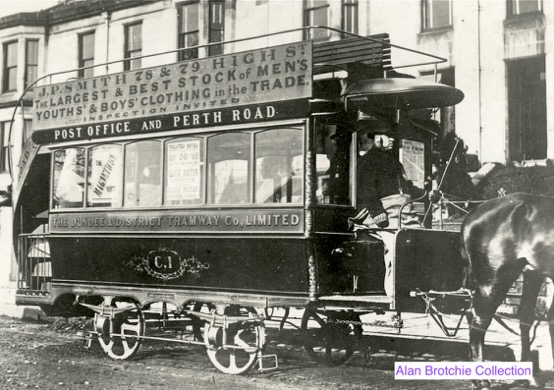
A very early shot of Horsecar C.I at the terminus at Dalhousie Terrace in 1879. The driver is wearing robust but informal attire, typical of horse bus and coach drivers.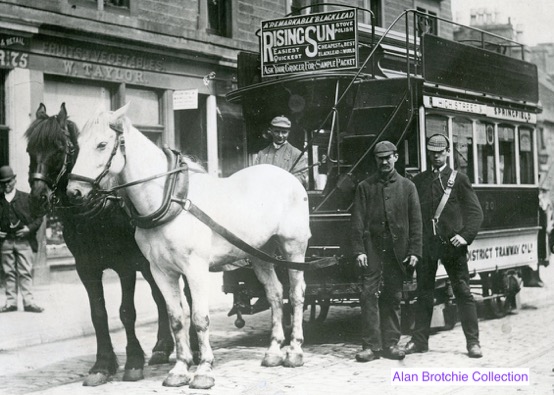
The driver (left) and conductor (right) of Horsecar No 20, along with an unidentified individual (centre), in Perth Road — photo undated, but judging by the pristine condition of the tram, probably not long after its delivery in 1891. 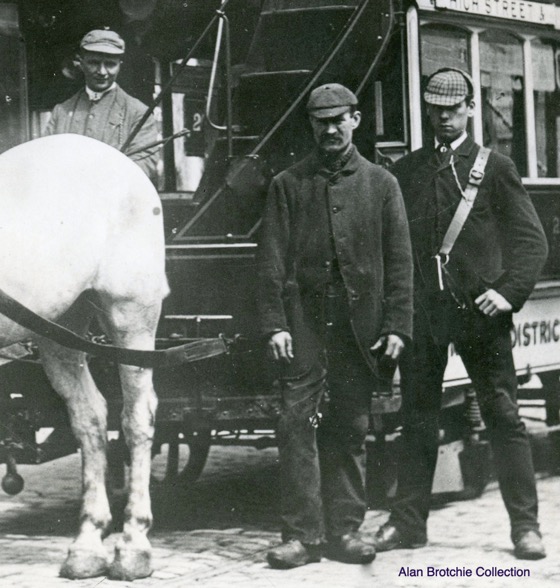
An enlargement of the above photograph showing the crewmen in their robust but clearly informal attire.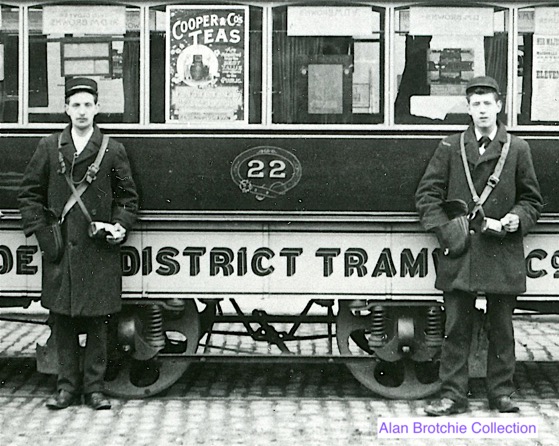
Two conductors stand with Horsecar No 22 (which was new in 1895) outside the depot in Perth Road, in November 1896. By this time, the company had clearly begun issuing uniforms or perhaps requiring the men to buy them, even though the coats and kepi-style caps bore no insignia whatsoever. 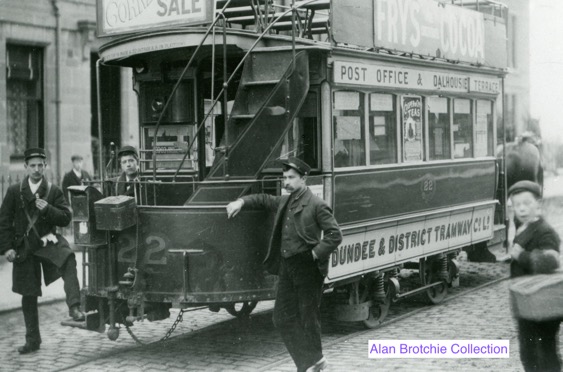
Another shot of Horsecar No 22 in Perth Rd, with a conductor (left) and two other tramway employees, taken in November 1896.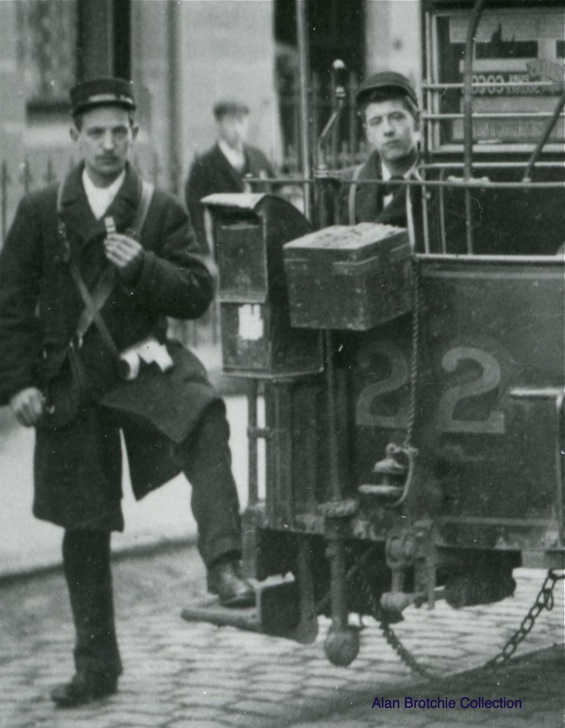
An enlargement of the above photograph, which clearly shows that the uniforms were completely devoid of insignia.
Steam tram drivers and conductors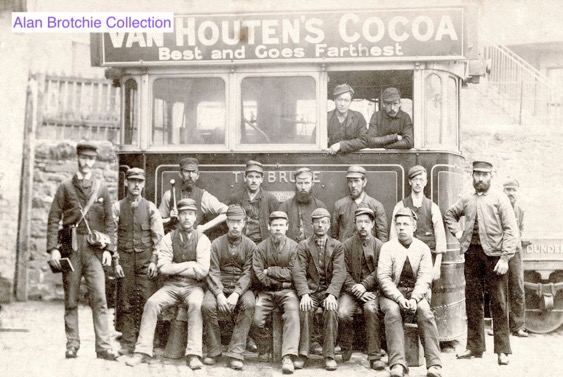
A superb photograph of one conductor, at least one engine crew, and several fitters, taken at Lochee Depot with Engine No 8 ('THE BRUCE'), a Thomas Green & Son product delivered in 1887. Although the photo is undated, the engine would appear to be in quite good condition, suggesting that it was taken within a couple of years of its delivery.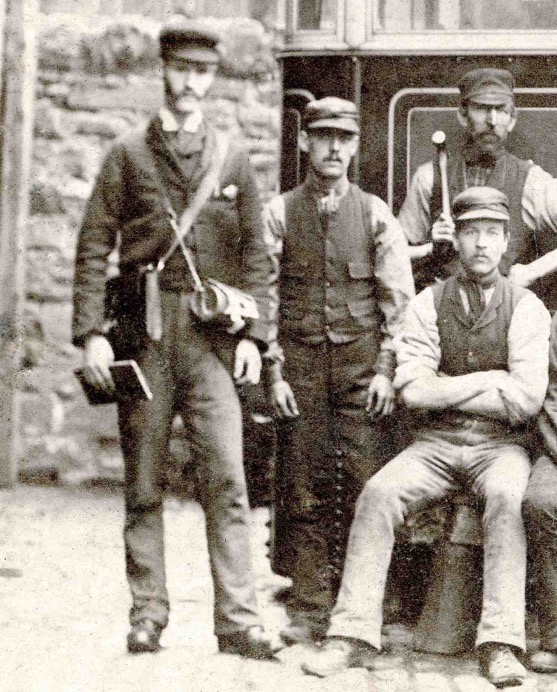
An enlargement of the above photograph showing the conductor. Although slightly out of focus, he is clearly wearing informal (though smart) attire, comprising a short jacket, waistcoat, and soft-topped cap, all devoid of insignia. The men to his left are wearing fairly typical footplate/fitter attire, all without badges of any kind.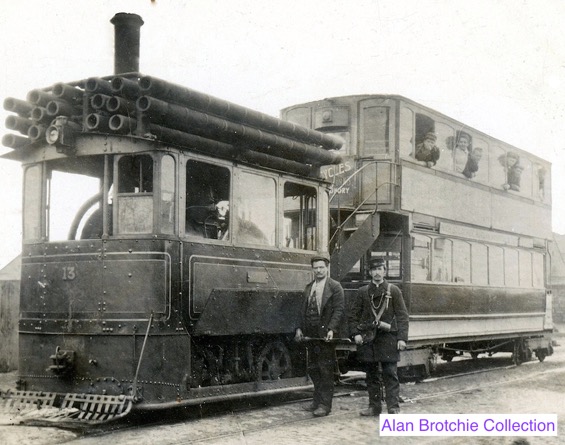
A rather unusual shot of the crew of Steam Tram No 13 (a Thomas Green & Son product delivered in 1894) with the side access flap open — photo undated, but probably taken circa 1897.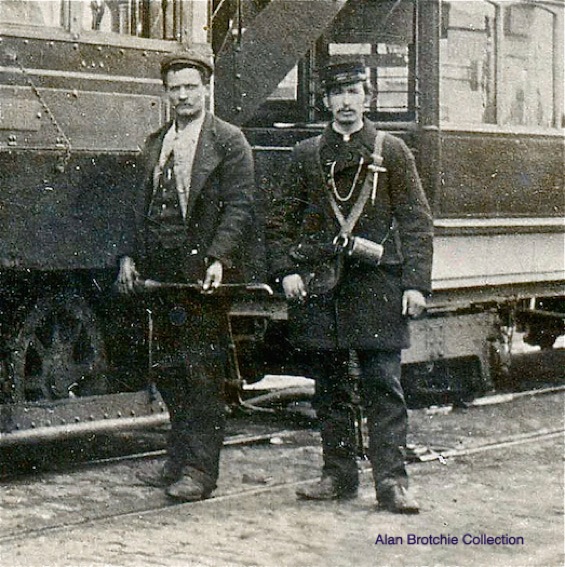
An enlargement of the above photograph showing the driver and the conductor. Although the latter is clearly wearing a uniform, it is completely devoid of insignia.
Senior staff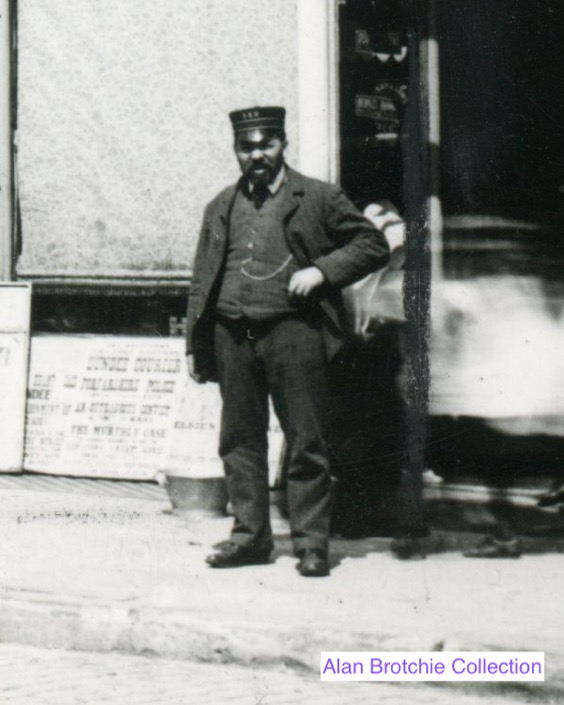
A photograph of an individual taken opposite the tram depot in Perth Road — undated. It is possible, though far from certain, that he is a D&DTCo inspector.